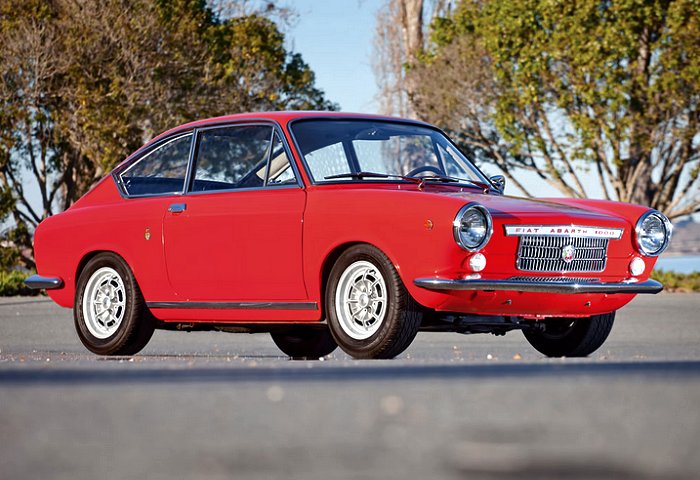The autumn of 1965 marked the debut of a remarkable Italian thoroughbred — the Abarth OTR 1000 Coupé. This pocket rocket emerged from the collaboration between Carlo Abarth’s racing expertise and Bertone’s design mastery, creating a vehicle that would become one of the most sought-after classics of its era.
Born in the golden age of Italian automotive design, this compact powerhouse packed nearly 75 horsepower into a featherweight 760kg frame. The result? A nimble performer that could dance through corners with the grace of a ballet dancer while maintaining the aggressive stance of a boxer ready to strike.
Design Legacy: Bertone’s Masterpiece
The OTR 1000 Coupé showcases Bertone’s ability to blend form and function in a compact package. The sleek, flowing lines of the bodywork maintain their visual impact even today, proving that truly exceptional design transcends time. Every curve and contour serves a purpose, from the carefully crafted air intakes to the aerodynamic profile that helps plant the car to the road.
Historical Reference!
Nuccio Bertone personally oversaw the design process, ensuring that the OTR 1000 Coupé would embody the perfect balance between racing functionality and aesthetic excellence.
“The OTR 1000’s body design represents one of the finest examples of 1960s Italian coachbuilding. The way the greenhouse flows into the tail section creates a visual harmony that many modern sports cars still struggle to achieve.” — Marco Rossi, Classic Car Restoration Specialist
The car’s compact dimensions — just 3608mm in length — belie its muscular presence. The greenhouse sits low and tight, while the wheel arches flare subtly to accommodate the wider track needed for improved handling. Chrome trim remains minimal, letting the purity of the form speak for itself.
Power and Performance
Under the hood lurks the heart of this Italian stallion — a naturally aspirated 982cc inline-four engine. While this might sound modest by today’s standards, the engine’s construction and tuning tell a different story. The combination of a 65mm bore and 74mm stroke allowed for excellent breathing characteristics and a willingness to rev that became Abarth’s hallmark.
The engine’s specifications deserve attention:
- precision-engineered cylinder head for optimal combustion;
- perfectly balanced crankshaft reducing vibration;
- high-flow intake system maximizing power delivery;
- race-derived valve timing enhancing top-end performance;
- specially designed exhaust system optimizing back pressure.
“These engines were built with racing DNA. The attention to detail in the cylinder head porting and valve train geometry shows that Abarth understood how to extract maximum performance from minimal displacement.” — Giuseppe Bianchi, Vintage Racing Engine Specialist
The four-speed manual transmission, while basic by modern standards, offers precise gear selection and well-chosen ratios that keep the engine in its sweet spot. The rear-wheel-drive layout, combined with the car’s minimal weight, creates a pure driving experience that modern electronics can’t replicate.
Racing Heritage and Impact
The OTR 1000 Coupé quickly established itself in European motorsport, where its combination of light weight and robust power made it a formidable competitor in its class. The car’s racing success helped establish Abarth’s reputation for building giant-killers — cars that could outperform rivals with significantly larger engines.
Fact!
Despite its limited production run, the OTR 1000 Coupé secured multiple class victories in Italian hillclimb events during 1966, cementing its reputation as a serious performance machine.
Each victory on the track enhanced the model’s desirability on the street. Racing improvements regularly found their way into production cars, creating a virtuous cycle of development that benefited both competition and road-going examples.
The racing program’s influence extends beyond mere competition success. The knowledge gained from pushing these cars to their limits led to improvements in production techniques and reliability that benefited all subsequent Abarth models.
Collector’s Perspective
Today, the Abarth OTR 1000 Coupé occupies a unique position in the classic car market. Its rarity — thanks to limited production numbers — combines with its historical significance to create strong demand among collectors. However, ownership requires dedication and specialist knowledge.
Parts availability presents both challenges and opportunities. While some components can be sourced from standard Fiat 600 models, many Abarth-specific parts require either careful restoration of original pieces or custom fabrication by specialists.
Important!
When evaluating an OTR 1000 Coupé for purchase, authentication is crucial. Each car should be thoroughly documented and verified against factory records to confirm its originality.
The investment potential remains strong, particularly for authenticated examples with documented racing history or significant period competition modifications. However, the real value lies in the driving experience — these cars were built to be driven and continue to deliver excitement behind the wheel.
The Legacy Lives On
Time has been kind to the OTR 1000 Coupé, its reputation growing stronger with each passing year. The combination of Bertone’s timeless design and Abarth’s engineering excellence created something greater than the sum of its parts — a true driver’s car that continues to captivate enthusiasts more than half a century after its introduction.
These cars remind us of an era when automotive excellence was measured not by computational power or electronic aids, but by the purity of the connection between driver and machine. Each surviving example tells a story of Italian automotive artistry at its finest.
| Pros | Cons |
|---|---|
| Exceptional handling and balance due to lightweight design | Limited parts availability requires specialist knowledge |
| Timeless Bertone styling that draws attention at any gathering | High maintenance costs due to specialized components |
| Strong investment potential given rarity and historical significance | Small interior space may challenge taller drivers |
| Pure driving experience without electronic interference | Requires careful authentication to verify originality |
| Racing pedigree adds historical value | Restoration costs can be significant |
| Excellent power-to-weight ratio | Limited practicality for regular use |
| Strong enthusiast community support | Vulnerability to rust in certain areas |

